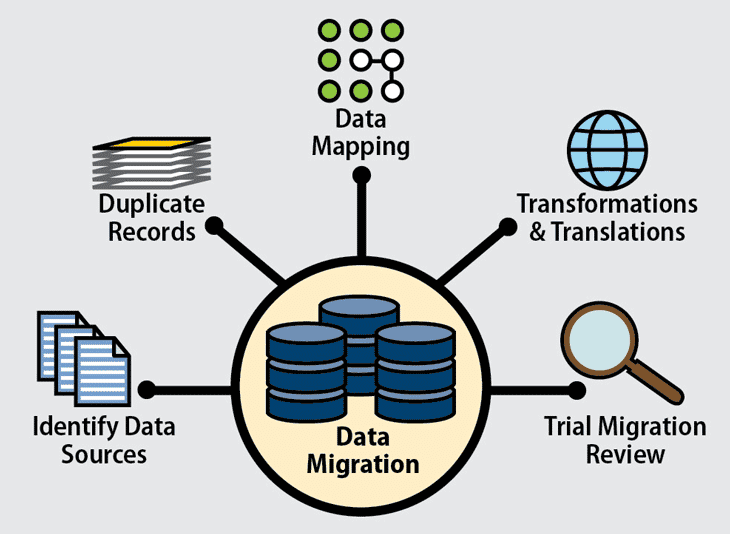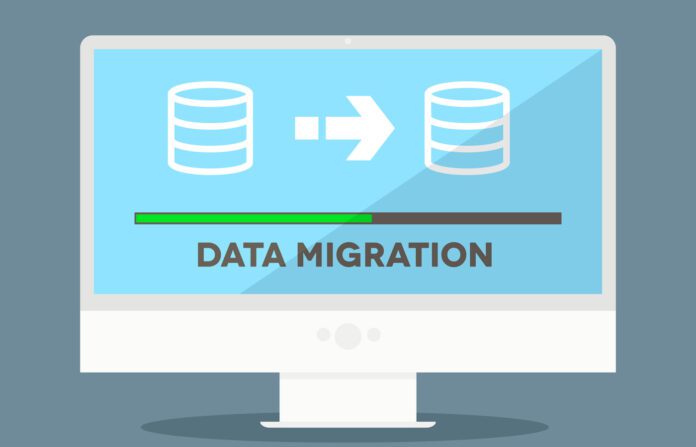Data migration is the process of moving existing data from one location to another—for example, from an existing database to a new one, from on-premises storage to the cloud, or to a new storage device. Because many scenarios require businesses to migrate their data, it’s a common practice, but one that’s fraught with risk. Data migration is a complex process with multiple stages. A careful strategy that involves all the right stakeholders and plans for possible contingencies can mitigate the risks. This article explains the process and types of data migration, lays out the challenges, and explains the best practices and strategies that will increase the chances of success.
Types of Data Migrations
While all data migrations need to be approached with a well-thought out strategy, careful mapping, and a detailed plan, the details of the plan vary depending on the type of migration.
Storage Migration
A data storage migration transfers data from one storage medium to another—for example, from hard drives to tapes. Data validation can reduce the amount of obsolete and corrupted data moved to the new system as blocks of storage and files are transferred from one medium to another.
Database Migration
In a database migration, database files are moved to a new or upgraded system—when companies change database vendors, upgrade their current database, or move a database to the cloud, for example. The existing database should be backed up and a quality assurance process put in place before the data is moved to the target source.
Application Migration
In an application migration, data is moved from to a new environment—for example, from an on-premises application to a cloud provider’s environment or data center. Migration is the preferred option over rebuilding an existing application, though the process can be complicated by customized applications.
Cloud Migration
Cloud migration is a comprehensive transfer that moves all of a business’s data, applications, services, and IT processes—essentially, the entire business operations—to the cloud. This could involve moving from an on-premises solution or a data center to the cloud, or from one cloud vendor to another.
Data Migration Best Practices
Regardless of the type, but all migration plans have four common phases: preparation, planning, execution, and quality assurance testing and optimization. Even with a solid plan, complicating factors can make data migrations difficult. The following best practices can help ensure success.
Hire a Migration Consultant
Businesses without staff experienced in migrations should hire a migration consultant to help them plan and execute the migration. Too many things can go wrong, putting data and business continuity at risk—rather than playing it by ear, bringing in an experienced professional can help ensure success.
Complete a Migration Assessment
A migration assessment—a questionnaire organizations can complete to better understand the various components of a planned migration—can help you identify the right approach, establish a budget and devote resources, and determine a timeline.
Involve Stakeholders
Communicating the migration plan to everyone who will be affected can ensure that everything that needs to be considered is considered, and that all the right data is being moved. It can also help with the migration itself by making sure everyone who uses the data knows when it is happening so that no data gets lost, duplicated, or corrupted.
Create a Backup and Recovery Plan
It’s critical to backup all data scheduled to be migrated, and to establish a rollback and recovery plan in case things don’t go as planned. This can help minimize any unexpected downtime and ensure business continuity.
Use the Right Tools for the Job
Assess vendors and platforms to find the right migration tool for your specific needs, and test it to make sure it works as promised and that you know how to use it. Then test the migration process, as well, to look for weaknesses or liabilities in the plan—it’s better to find them during the rehearsal than the actual migration.
Understand Your Data and Systems
The data to be migrated should be included in the assessment process. What’s the quality like? Does it need to be cleaned, reformatted, or otherwise prepared? Your teams and systems should, too—do all staff involved know how the migration process and tools work? Are they clear on the timeline?
Migrate at Off-Peak Hours
Most businesses need to remain operational throughout the migration process—especially larger enterprise businesses that run round-the-clock. Shutting down for even a few hours could damage business continuity and lose customers. Plan migrations for non-peak hours or schedule them for holiday weekends, for example, when traffic is minimal.
Audit and Document the Process
Keeping careful documentation can help you understand all the pieces of a migration process, making it easier to troubleshoot anything unexpected and plan for contingencies. Even after the migration is complete, continue to test, audit, and document all the systems and data—problems don’t always reveal themselves immediately.

Data Migration Challenges and Risks
Data migrations are complex processes involving lots of steps, many people, and disparate tools and systems. There are many opportunities for things to go wrong. Even the best-laid plans sometimes can’t account for all possibilities, but a well-considered strategy can prepare you for unexpected events when they do happen.
Here are the most common issues to watch out for with a data migration.
- Data loss. To guard against the ever-present risk of losing data during a migration, all data should be backed up and a recovery plan put in place. Post migration, test to confirm that historical data made it to the new system.
- Data corruption. Migrating erroneous, unwanted, or corrupt data into a target system can crash the system or corrupt validated historical data. Audit data types and sources before moving data to the target system to minimize the chances.
- Security risks. Migrations can put data at risk, exposing it to third-party vendors or moving it into a vulnerable system susceptible to exploits. A good migration strategy should include a data security component, and the security of target systems should be taken into account during the selection process.
- Degraded performance. During a migration, performance can be affected by bugs, over-taxed systems, or unreliable migration tools. Consider the pacing of the migration and make sure all systems are up to the task.
- Semantics errors. Migrated data can fail if semantic errors occur due to incorrect fields or records or inaccurate processing. Rigorous migration testing in advance of the actual migration can minimize the risk.
- Prolonged downtimes. When things go wrong with a migration, they can cause delays—and multiple problems can compound, prolonging the migration and extending the switchover. This can lead to lost revenues or customers. Make sure your service level agreement (SLA) with the consultant or migration company promises and guarantees an acceptable deadline.
- Human error. Human-generated mistakes can tank a migration, no matter how well-planned. The best way to prevent this is to train everyone involved. Make sure they understand the tools, their roles, and the timeline, and that they are clear on the procedure.
Data Migration Strategy: How to Migrate Data Successfully
A good data migration strategy will minimize cost, data loss, and downtime and give the highest chances for success. At the very least, it needs to specify a migration approach and establish a timeline, identify the migration tool or tools to be used, and outline a process for validating data. It should also establish a migration team made up of internal stakeholders and a migration expert, either on-staff or a consultant, who will lead the process. In addition, a data migration strategy should plan for the following migration components.
Migration Approach
One of the first decisions in a migration strategy is determining the migration approach. There are two popular choices. A Big Bang migration occurs in one single operation in which all data is transferred in a specified period—for example, over a weekend. A Trickle migration is a gradual transfer of data to a target system, and allows a business to run the old and new systems in parallel for a defined period.
The Big Bang approach is less time-consuming, but requires the system to be offline during the entire migration. It’s typically used by small businesses that are not required to be operational around the clock. The trickle migration is preferred by enterprise organizations that cannot pause operations for long windows of time. This type of migration also makes it easier to detect and resolve possible migration issues.
Migration Team
The migration approach will determine who should be included on the migration team. A data migration specialist should be contracted as a consultant if no one on staff has the experience and expertise. Internal team members should recognize the migration is a high priority and that priority-level effort must be maintained for the duration of the project.
Data Assessment and Cleanup
The data assessment process validates data to be moved to the target and identifies any inconsistencies before it is moved. Incomplete or inaccurate data and other data quality anomalies must be cleaned up if the data is to migrate to the target system; otherwise, it should be deleted. Data migration tools can be helpful in the cleanup effort.
Data Security and Governance
Having a strategy for data governance can ensure the quality and integrity of the data throughout the migration process and track and report on the status of the data and the progress of the migration. Automated migration tools can be invaluable with this stage of the migration, as well, and should be part of the plan.
Bottom Line: The Importance of Data Migration
There are any number of reasons why businesses might migrate their data. They could be implementing new customer relationship management (CRM) software or a financial system and need to move all the records from the old platform, upgrading legacy systems to reduce their data storage footprint and resources, or shifting from on-premises storage to the cloud.
What all these scenarios have in common is the goal of improving operations. A successful data migration process is critical to the success of these efforts.
A lot of time and money goes into selecting and implementing a new software platform, for example. It can make staff more efficient and streamline operations. But if the data from the old system is not migrated correctly, it could render the new system useless—or worse. Years of customer data, financial transactions, and historical records could be inaccessible, corrupted, or lost.
Nearly every enterprise will need to undergo a data migration at some point. While the process can be fraught, a well-thought out strategy can minimize risk and mitigate the effects of any unforeseen calamities—as can working with experienced experts, either on-staff or as consultants.
To learn more about keeping data safe, read What is Data Storage Security: What You Need to Know.






